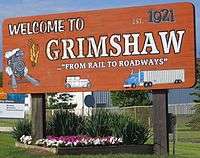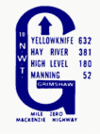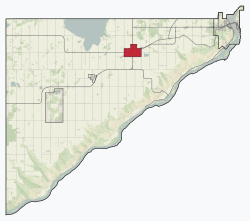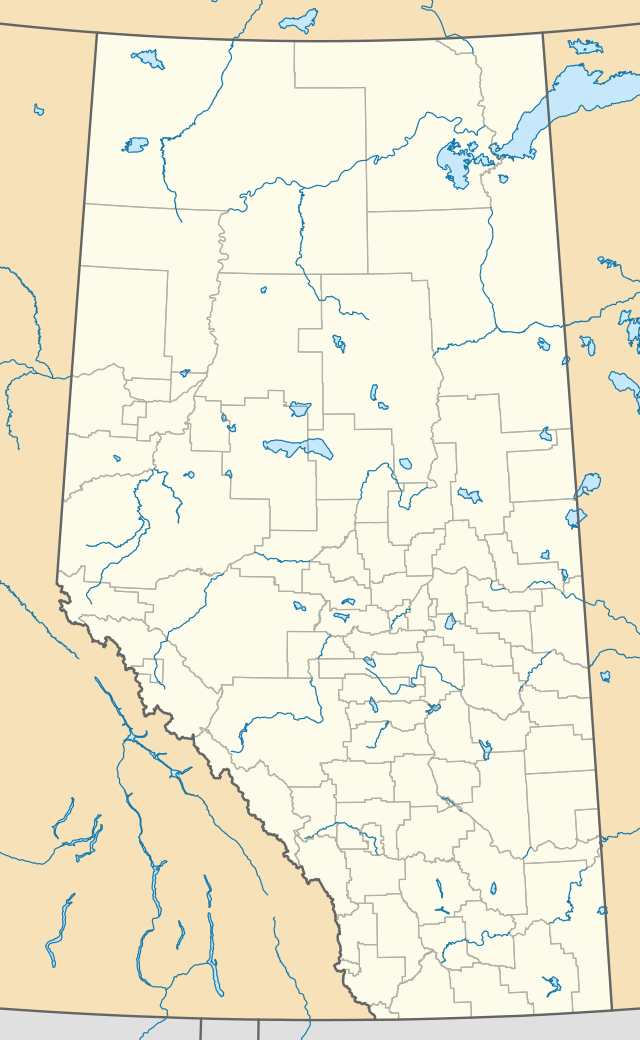Grimshaw, Alberta
Grimshaw is a town in northern Alberta located 25 km (16 mi) west of the town of Peace River at the junction of Highway 35, Highway 2, and bypass Highway 2A, and the Mackenzie Northern Railway. By virtue of being the original starting point of Highway 35, which leads to the Northwest Territories, Grimshaw is referred to as Mile Zero of the Mackenzie Highway.
Grimshaw | |
|---|---|
Town | |
| Town of Grimshaw | |
 Boundary sign | |
 Seal | |
 Location in the MD of Peace No. 136 | |
 Grimshaw Location of Grimshaw in Alberta | |
| Coordinates: 56°11′27″N 117°36′42″W | |
| Country | Canada |
| Province | Alberta |
| Region | Northern Alberta |
| Planning region | Upper Peace |
| Municipal district | Municipal District of Peace No. 135 |
| Incorporated[1] | |
| • Village | February 18, 1930 |
| • Town | February 2, 1953 |
| Government | |
| • Mayor | Bob Regal |
| • Governing body | Grimshaw Town Council |
| Area (2016)[3] | |
| • Land | 7.09 km2 (2.74 sq mi) |
| Elevation | 603 m (1,978 ft) |
| Population (2016)[3] | |
| • Total | 2,718 |
| • Density | 383.4/km2 (993/sq mi) |
| Time zone | UTC-7 (MST) |
| Highways | Highway 2 Highway 35 |
| Waterway | Lac Cardinal |
| Website | Official website |
History
The town was named after Dr. M.E. Grimshaw, a pioneer doctor from Kingston, Ontario who settled in Peace River (then known as Peace River Crossing) in 1914.[5] He practised in the area for many years and also served at different capacities in the local government at the county and the village levels until 1922, retiring from politics as the mayor of Peace River. In 1929 he moved his family to Fairview, where he died in November of that year. Dr. Grimshaw would later be the posthumous father-in-law of actor John Carradine, who was married to Grimshaw's daughter, Doris Grimshaw (Doris Erving, Doris Rich), from 1957 until her death in 1971.[6]
- Timeline
- 1917: Grimshaw's location was chosen by the Central Canada Railway.[7]
- 1921: Originally surveyed by Alfred Driscoll.
- 1930: The hamlet was incorporated as the "Village of Grimshaw".
- 1953: Grimshaw was incorporated as a town.
Demographics
| Year | Pop. | ±% |
|---|---|---|
| 1931 | 137 | — |
| 1936 | 129 | −5.8% |
| 1941 | 169 | +31.0% |
| 1946 | 287 | +69.8% |
| 1951 | 564 | +96.5% |
| 1956 | 904 | +60.3% |
| 1961 | 1,095 | +21.1% |
| 1966 | 1,376 | +25.7% |
| 1971 | 1,714 | +24.6% |
| 1976 | 1,665 | −2.9% |
| 1981 | 2,316 | +39.1% |
| 1986 | 2,579 | +11.4% |
| 1991 | 2,812 | +9.0% |
| 1996 | 2,661 | −5.4% |
| 2001 | 2,435 | −8.5% |
| 2006 | 2,537 | +4.2% |
| 2011 | 2,515 | −0.9% |
| 2016 | 2,718 | +8.1% |
| Source: Statistics Canada [8][9][10][11][12][13][14][15][3] | ||
In the 2016 Census of Population conducted by Statistics Canada, the Town of Grimshaw recorded a population of 2,718 living in 1,061 of its 1,194 total private dwellings, a change of 8.1% from its 2011 population of 2,515. With a land area of 7.09 km2 (2.74 sq mi), it had a population density of 383.4/km2 (992.9/sq mi) in 2016.[3]
In the 2011 Census, the Town of Grimshaw had a population of 2,515 living in 984 of its 1,093 total dwellings, a change of -0.9% from its 2006 population of 2,537. With a land area of 7.21 km2 (2.78 sq mi), it had a population density of 348.8/km2 (903.4/sq mi) in 2011.[16]
Economy
Having developed first as a community centre for a rich mixed farming district,[17] Grimshaw's economy has transformed to become a distribution centre for northern Alberta.
Arts and culture
Some annual festivals and events in the Grimshaw area include the following:
- Family Day Celebration in February at Lac Cardinal
- Alberta Pond Hockey tournament in February at Lac Cardinal
- Senior Citizens Week Celebration in June
- Annual Country Fair in June
- Pioneer Days at Lac Cardinal Pioneer Village Museum in August
- North Peace Stampede in August at Lac Cardinal Recreation Area
- Annual Terry Fox Run in September
- Old Fashioned Family Christmas Event at Lac Cardinal Pioneer Museum in December
Attractions
The Town of Grimshaw has numerous indoor and outdoor recreational facilities within its borders including an outdoor swimming pool, an arena, a curling rink, a family fitness centre, 6 Ball Diamonds, SK8 "N" Bike Park, an R.V. Park and a Seniors Drop In Centre.
The Historic Mile 0 Mackenzie Park and the Tom Baldwin Memorial Arboretum located at the corner of Highway 2 and Highway 2A are fully landscaped passive recreational interpretive park reflecting local and regional history. The history of the communities along the Mackenzie Highway is reflected by interpretive signs situated along the walking path. The Tom Baldwin Memorial Arboretum provides an educational component to visitors and the local schools to learn about the different species of trees in the area forests. [18] Queen Elizabeth Provincial Park and Lac Cardinal Recreation Area on the shores of Lac Cardinal are less than 10 kilometres to the northwest of Grimshaw. Wilderness Park is less than 5 kilometres to the northeast of Grimshaw.
Museums include the Lac Cardinal Pioneer Village Museum and the Mile 0 Antique Truck Museum. Located within Lac Cardinal Recreation Area, the Lac Cardinal Pioneer Village Museum features buildings from a pioneer townsite. The Mile 0 Antique Truck Museum displays trucks used in northern cartage in the 1930s through 1950s. The museum specializes in International Trucks, and has many that are fully restored to show room condition. The museum has been nominated for numerous awards.[19]
Infrastructure
Health care
The Grimshaw Berwyn & District Community Health Centre provides the health needs of residents for Grimshaw, Berwyn and nearby communities. Other hospitals in the area include the Peace River Community Health Centre in Peace River, and the Manning Community Health Centre in Manning.
The medical clinic is located in the town's downtown core. Dental services are also available in Grimshaw.
Education
Public schools in Grimshaw include the Grimshaw Public School (Grades K to 12). Separate schools include Holy Family Elementary School (Grades K to 9) with senior high school students being bussed to Glenmary School [Grades 7-12] in Peace River.
Post-secondary education is available at Northern Lakes College in the Peace River Campus.
Media
Grimshaw is served weekly by the Mile Zero News[20] and bi-weekly by alternative newspaper The Vault Magazine.[21]
Government
Grimshaw is in the Peace River federal electoral district, served by Chris Warkentin. In the next federal election, Grimshaw will become part of the newly formed riding of Peace River—Westlock.
References
- "Location and History Profile: Town of Grimshaw" (PDF). Alberta Municipal Affairs. October 7, 2016. p. 288. Retrieved October 13, 2016.
- "Municipal Officials Search". Alberta Municipal Affairs. September 22, 2017. Retrieved September 25, 2017.
- "Population and dwelling counts, for Canada, provinces and territories, and census subdivisions (municipalities), 2016 and 2011 censuses – 100% data (Alberta)". Statistics Canada. February 8, 2017. Retrieved February 8, 2017.
- "Alberta Private Sewage Systems 2009 Standard of Practice Handbook: Appendix A.3 Alberta Design Data (A.3.A. Alberta Climate Design Data by Town)" (PDF) (PDF). Safety Codes Council. January 2012. pp. 212–215 (PDF pages 226–229). Retrieved October 8, 2013.
- "History". The Town of Grimshaw. Retrieved 2017-07-02.
- Oxnard Press-Courier, May 18, 1971, pp. 1-2
- "The Central Canada Railway". Atlas of Alberta Railways. University of Alberta Press. Retrieved 2017-07-02.
- "Table 5: Population of urban centres, 1916-1946, with guide to locations". Census of the Prairie Provinces, 1946. Volume I: Population. Ottawa: Dominion Bureau of Statistics. 1949. pp. 397–400.
- "Table 6: Population by sex, for census subdivisions, 1956 and 1951". Census of Canada, 1956. Volume I: Population. Ottawa: Dominion Bureau of Statistics. 1958.
- "Table 9: Population by census subdivisions, 1966 by sex, and 1961". 1966 Census of Canada. Western Provinces. Population: Divisions and Subdivisions. Ottawa: Dominion Bureau of Statistics. 1967.
- "Table 3: Population for census divisions and subdivisions, 1971 and 1976". 1976 Census of Canada. Census Divisions and Subdivisions, Western Provinces and the Territories. Population: Geographic Distributions. Ottawa: Statistics Canada. 1977.
- "Table 2: Census Subdivisions in Alphabetical Order, Showing Population Rank, Canada, 1981". 1981 Census of Canada. Census subdivisions in decreasing population order. Ottawa: Statistics Canada. 1982. ISBN 0-660-51563-6.
- "Table 2: Population and Dwelling Counts, for Census Divisions and Census Subdivisions, 1986 and 1991 – 100% Data". 91 Census. Population and Dwelling Counts – Census Divisions and Census Subdivisions. Ottawa: Statistics Canada. 1992. pp. 100–108. ISBN 0-660-57115-3.
- "Population and Dwelling Counts, for Canada, Provinces and Territories, and Census Divisions, 2001 and 1996 Censuses – 100% Data (Alberta)". Statistics Canada. Retrieved 2019-05-25.
- "Population and dwelling counts, for Canada, provinces and territories, and census subdivisions (municipalities), 2006 and 2001 censuses – 100% data (Alberta)". Statistics Canada. January 6, 2010. Retrieved 2019-05-25.
- "Population and dwelling counts, for Canada, provinces and territories, and census subdivisions (municipalities), 2011 and 2006 censuses (Alberta)". Statistics Canada. 2012-02-08. Retrieved 2012-02-08.
- http://www.grimshaw.ca/visiting/
- http://mightypeace.com/places-to-visit-2/communitiesmunicipalities/grimshaw
- "Archived copy". Archived from the original on 2012-09-18. Retrieved 2012-10-24.CS1 maint: archived copy as title (link)
- http://mrnews.ca/mile-zero-news-mrnews
- "Archived copy". Archived from the original on 2015-04-25. Retrieved 2015-05-22.CS1 maint: archived copy as title (link)